
Groudle Glen Railway
Encyclopedia
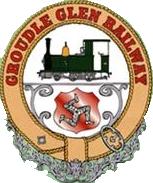
Douglas, Isle of Man
right|thumb|250px|Douglas Promenade, which runs nearly the entire length of beachfront in Douglasright|thumb|250px|Sea terminal in DouglasDouglas is the capital and largest town of the Isle of Man, with a population of 26,218 people . It is located at the mouth of the River Douglas, and a sweeping...
in the Isle of Man
Isle of Man
The Isle of Man , otherwise known simply as Mann , is a self-governing British Crown Dependency, located in the Irish Sea between the islands of Great Britain and Ireland, within the British Isles. The head of state is Queen Elizabeth II, who holds the title of Lord of Mann. The Lord of Mann is...
which is owned and operated by members of the Isle of Man Steam Railway Supporters' Association
Isle of Man Steam Railway Supporters' Association
The Isle of Man Steam Railway Supporters' Association is a railway preservationist group dedicated to the continued operation of the Isle of Man Railway on the Isle of Man Since its inception in 1966 the group have provided volunteer workers and a watchdog role and commenced its own project in the...
and operates on summer Sundays; May to September and Wednesday evenings in July and August along with a number of annual special events.
History
1896 – 1939Built in the late Victorian era
Victorian era
The Victorian era of British history was the period of Queen Victoria's reign from 20 June 1837 until her death on 22 January 1901. It was a long period of peace, prosperity, refined sensibilities and national self-confidence...
in response to increasing demand for transportation down Groudle Glen
Groudle Glen
Groudle, a glen on the outskirts of Onchan on the Isle of Man, is formed in a valley leading to the sea at the small port of the same name. It was a remote hamlet boasting only a handful of small cottages until linked to the Manx Electric Railway in 1893, at which time it was developed as a...
brought on by the introduction of the Manx Electric Railway
Manx Electric Railway
The Manx Electric Railway is an electric inter-urban tramway connecting Douglas, Laxey and Ramsey in the Isle of Man. It connects with the Douglas Bay Horse Tramway at its southern terminus at Derby Castle at the northern end of the promenade in Douglas, and with the Snaefell Mountain Railway at...
. The headland was developed, with a zoo
Zoo
A zoological garden, zoological park, menagerie, or zoo is a facility in which animals are confined within enclosures, displayed to the public, and in which they may also be bred....
being created and the railway being built. The gauge line ran from the upper part of the glen, Lhen Coan, to the Zoo at Sea Lion Rocks. The line opened on May 23, 1896 and started with one engine, called Sea Lion, and three coaches. The engine was built by W.G. Bagnall Ltd.
W.G. Bagnall
W. G. Bagnall was a locomotive manufacturer from Stafford, England. It was founded in 1875 by William Gordon Bagnall and ceased trading in 1962 when it was taken over by English Electric Co Ltd. The company was located at the Castle Engine Works, in Castle Town, Stafford...
of Castle Engine Works, Stafford
Stafford
Stafford is the county town of Staffordshire, in the West Midlands region of England. It lies approximately north of Wolverhampton and south of Stoke-on-Trent, adjacent to the M6 motorway Junction 13 to Junction 14...
. The line became so popular that a further engine, Polar Bear, and additional coach stock was purchased. The railway operated very successfully until the outbreak of the First World War when all services ceased and the associated zoo was closed. When the line re-opened the locomotives were overhauled and returned to service but by 1921 they had been replaced with battery-operated
Battery (electricity)
An electrical battery is one or more electrochemical cells that convert stored chemical energy into electrical energy. Since the invention of the first battery in 1800 by Alessandro Volta and especially since the technically improved Daniell cell in 1836, batteries have become a common power...
engines. These proved troublesome and after proving inefficient and costly, they were dropped, the original steam locomotives being overhauled and returned to service. The railway once again closed during the Second World War and the zoo closed for good, it being reported that the animals had been released! A landslide during the war years ensured that services could not return to the original terminus.
1950 – 1981
The line took some time to re-open after the war, the draw of the zoo being lost meaning the glen itself was less frequently visited. Only one locomotive returned, for the 1950 season but over the next twelve years the seasons were somewhat sporadic and no timetable was officially issued. 1962 proved the final season, with "Polar Bear" refusing to hold a head of steam. The final two seasons were known as the "fairground era" as the stock was all painted in loud colours with blue and red dominating, and fairground-style lettering and lining applied to the locomotive. By the late 1960s the engines had been removed from the glen and Polar Bear was restored as an operating exhibit at Amberley Working Museum
Amberley Working Museum
Amberley Museum & Heritage Centre is a museum at Amberley, near Arundel in West Sussex, England.The museum was founded in 1979 by the Southern Industrial History Centre Trust and has previously been known as the Amberley Working Museum, Amberley Chalk Pits Museum or plain Amberley Museum.The museum...
, West Sussex
West Sussex
West Sussex is a county in the south of England, bordering onto East Sussex , Hampshire and Surrey. The county of Sussex has been divided into East and West since the 12th century, and obtained separate county councils in 1888, but it remained a single ceremonial county until 1974 and the coming...
and Sea Lion was taken to Loughborough
Loughborough
Loughborough is a town within the Charnwood borough of Leicestershire, England. It is the seat of Charnwood Borough Council and is home to Loughborough University...
where it remained until 1987 when it was finally restored and returned to service on the restored line. The railway became a footpath, only to be disturbed by the occasional walker. It seemed that this unique piece of Manx heritage was lost. Much of the railway's infrastructure was lost at this time, the distinctive station canopy being demolished in 1979 and the remaining smaller buildings lost also.
1982 – 1991
In 1982, the Isle of Man Steam Railway Supporters' Association
Isle of Man Steam Railway Supporters' Association
The Isle of Man Steam Railway Supporters' Association is a railway preservationist group dedicated to the continued operation of the Isle of Man Railway on the Isle of Man Since its inception in 1966 the group have provided volunteer workers and a watchdog role and commenced its own project in the...
launched a plan to restore the line and work began clearing twenty years worth of undergrowth that had reclaimed the trackbed. In time for December 1983 a short section from the old lime kiln to the headland had been re-built and the railway commenced its Santa Train operation, now an established part of the island's social calendar. Little by little the line was relaid to the glen terminus of Lhen Coan and a station was created at the headland with run-round facilities. The railway was officially re-opened on 23 May 1986 by Carolyn Rawson as part of the Manx Heritage Year and a tree planted to mark the event in Lhen Coan station. The most significant event at this time was the return of the original steam locomotive "Sea Lion" in September 1987, which was much heralded in the local press. By 1991 the decision had been made to excavate the final section of the line from the headland loop to the former terminus at Sea Lion Rocks and the run-round loop was lifted at the end of the 1991 season when the major earthworks began to relay the original section to the outer terminus.
1992 – 2002
The extension, recreating the line to its original three quarter-mile length was duly opened on 23 July 1992, and this was followed in 1993 with the opening of the distinctive Swiss-style station canopy at Lhen Coan, a feature of so many postcards of the glen, as part of the Year Of Railways
Year of Railways
The Year of Railways was a series of special events held on the Isle of Man during 1993 to commemorate the centenary of the opening of the first section of the Manx Electric Railway from Douglas to Groudle in September 1893....
celebration. It was during this year that "Polar Bear" also returned to the glen for a visit. It was a time of great change for the line, with many improvements being introduced by the volunteers. Visiting locomotives were a feature in 1995 (Chaloner and Rishra) and in 1998 as part of the Steam 125
Steam 125
Steam 125 was a series of events held in 1998 to mark the 125th anniversary of the Isle of Man Railway opening its first route from Douglas to Peel the railway ran a large number of special events. Most notable was the return to service of the original steam locomotive No...
event marking the anniversary of the island's main railway. Planning permission was granted in 1999 for the volunteers to erect a replacement station building at Sea Lion Rocks and by the summer of 2000 work was well in hand. The station building opened the following year but it was in 2003 that the interior of the station was completed and since this time it has proved to be the major draw to the railway, aside from the unique steam locomotives. The station and surrounding area have since received much attention as ongoing projects and the development of the site has also revived interest in the amazing zoo that once drew in the crowds, the remains of which are still viewable from the station site.
2003 –
The addition of a replica battery electric locomotive in 2003 completed the line's historical line-up of locomotives and a return visit from Polar Bear for her own centenary in 2005 was repaid by Sea Lion making her first trip to Amberley Chalk Pits in the same year. Back on the railway, in 2007 a new purpose-built locomotive shed was erected on the site of the original, but to a larger scale, and a mess hut was installed making the station at Lhen Coan a transformed area, in keeping with the original site. In September 2007 the railway marked the twenty-fifth anniversary of restoration by unveiling a plaque at Lhen Coan station. This event also marked the official opening by Annie Craine
Annie Craine
Anne Valerie Craine JP MHK was the Minister for the Treasury for the Isle of Man between 2010 and 2011 and Member of the House of Keys for Ramsey. Before that, she was previously the Minister of Education between 2006 and 2010. She was elected at the 2003 by-election...
MHK
Member of the House of Keys
Member of the House of Keys, or MHK is the title given to a person who has been elected into the House of Keys, the lower house of Tynwald, the parliament of the Isle of Man. There are twenty-four Members of the House of Keys. Elections are held every five years; the last election took place in...
of the railway's new purpose built locomotive shed. Plans were well in hand to rebuild the souvenir shop at Lhen Coan in a style similar to the distinctive station canopy and the close of the 2008 season saw the previous incarnation dismantled in readiness for the erection of the new, pre-fabricated version on the same site. A mock signal box was also completed to cover the side of the volunteers' mess room in this year also, and by December work was in hand to close the shop for good after the Santa Trains. The new shop opened fully for Easter 2010 and now dominates the station site. In 2010 an appeal was launched to raise the £30,000 required to extend the Sea Lion Rocks Tea Rooms to provide toilet facilities, a power supply and improved patio area, this is due to be started during the 2011 season.
Stations
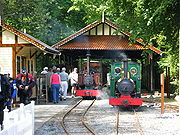
- Lhen Coan Station, the lower terminus where all the rolling stock is housed, the only intermediate halt on the railway, the halfway point
- Headland Station, now closed, one-time terminus of the line prior to 1991, outer terminus on the cliffs above the old zoo
Each of the railway's stations is now colour coded, with all station furniture, waiting shelters, etc., in a corresponding scheme. The terminus at Lhen Coan is in brown and cream (similar to Great Western Railway
Great Western Railway
The Great Western Railway was a British railway company that linked London with the south-west and west of England and most of Wales. It was founded in 1833, received its enabling Act of Parliament in 1835 and ran its first trains in 1838...
stations), with Lime Kiln Halt in a green scheme (similar to the Southern Railway
Southern Railway (Great Britain)
The Southern Railway was a British railway company established in the 1923 Grouping. It linked London with the Channel ports, South West England, South coast resorts and Kent...
) and Sea Lion Rocks in a bright shade of red/maroon. In the past each station was decorated in a house style of deep brown and cream throughout the period 1991-2000, changing to individual station colour schemes thereafter, although individual shades used have varied since this time.
Operations
SeasonalWhen it originally opened in 1896 the line ran a very intense all-day every-day service in season. A fourth coach was ordered within the first year to cope with demand, followed by a further locomotive and four coaches eight years later. Today is a different story, the railway operates to a set timetable annually with trains running every Sunday between May and September, with the first train at 11:00 am and final departure at 4:30 pm; in addition to this evening services operate between 7:00 pm and 9:00 pm on Wednesdays in July and August, and Tuesdays in August only. One of the resident steam locomotives is in service wherever possible for each of the advertised operating days. When the line first re-opened services were also provided on bank holidays and public holidays but this practice has been discontinued in more recent years. As part of the involvement with the Year Of Railways
Year of Railways
The Year of Railways was a series of special events held on the Isle of Man during 1993 to commemorate the centenary of the opening of the first section of the Manx Electric Railway from Douglas to Groudle in September 1893....
in 1993 and subsequent anniversaries, the line has operated daily for periods of up to one week, the last being as part of Steam 125
Steam 125
Steam 125 was a series of events held in 1998 to mark the 125th anniversary of the Isle of Man Railway opening its first route from Douglas to Peel the railway ran a large number of special events. Most notable was the return to service of the original steam locomotive No...
in 1998 when visiting locomotives were in attendance. The railway's current standard timetable can be found at its website including details of special services.
Christmas
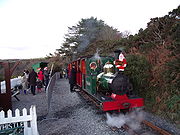
Easter

Easter Bunny
The Easter Bunny or Easter Rabbit is a character depicted as a rabbit bringing Easter eggs, who sometimes is depicted with clothes...
is on hand to distribute chocolate eggs at the outer terminus, second only to the Santa Trains these services which operate on Easter Sunday and Monday are the line's busiest and provide a bump start to each summer season.
Jester Express
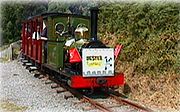
Merlin
Merlin is a legendary figure best known as the wizard featured in the Arthurian legend. The standard depiction of the character first appears in Geoffrey of Monmouth's Historia Regum Britanniae, written c. 1136, and is based on an amalgamation of previous historical and legendary figures...
, and King Arthur
King Arthur
King Arthur is a legendary British leader of the late 5th and early 6th centuries, who, according to Medieval histories and romances, led the defence of Britain against Saxon invaders in the early 6th century. The details of Arthur's story are mainly composed of folklore and literary invention, and...
in attendance to greet children; a set of stocks were the biggest draw for the children however, and these trains were very popular with local residents, with associated stalls, raffles and light refreshments being made available. A shortage of volunteer labour in subsequent years resulted in this innovative family day being dropped from the railway's calendar, but the event returned for the 2010 Season.
Other Events
As part of a new drive to attract more local visitors to the line and to recruit new volunteers to run the line, a wide programme of special events were introduced for the 2010 season. Alongside the annual Easter Bunny Trains and Santa Specials, the Jester Express Fun Day returned in July, alongside the new Diesel & Electric Day in May, the Father's Day Trains in June and the Teddy Bear's Picnic in August.
Another new initiative for 2010 was the introduction of Driver Experience sessions, bookable by the railway's website, a 2 hour session on the footplate of locomotive Annie is offered as a hands on experience. It is planned that this driver experience will be further developed in 2011 with the session becoming a 3 hour experience including the participant taking part in raising steam and preparing the locomotive, along with refreshments and an accompanying guest included in the price.
Locomotives


- Sea LionSea Lion (locomotive)Sea Lion is a steam locomotive built in 1896 to supply the motive power to the Groudle Glen Railway on the Isle of Man and the locomotive still provides the main traction there today. The locomotive was built by W.G. Bagnall & Co., Stafford and delivered to the line in May of that year, providing...
(1896) the line's original locomotive, restored and resident - Polar BearPolar Bear (locomotive)Polar Bear is a Bagnall steam locomotive built in 1905 for the Groudle Glen Railway, to supplement the similar Sea Lion. The two Bagnalls were temporarily taken out of service in the 1920s when they were replaced by a pair of battery locomotives. These proved unsatisfactory, and Polar Bear and...
(1905) now resident at the Amberley Museum RailwayAmberley Museum RailwayThe Amberley Museum and Heritage Centre Railway is a gauge railway based at the Amberley Museum and Heritage Centre, Amberley, West Sussex. It has a varied collection of engines and rolling stock ranging from gauge to gauge...
but has returned for visits - AnnieAnnie (locomotive)Annie is a steam locomotive that operates on the Groudle Glen Railway on the Isle of Man.-Design:She was built by Richard Booth to the design of a 1911 locomotive of the same name that was shipped to New Zealand to operate the Gentle Annie Tramway...
(1998) the island's newest locomotive, a replica of another locomotive - DolphinDolphin (locomotive)Dolphin is a diesel locomotive currently based on the Groudle Glen Railway. Dolphin has a sister locomotive Walrus.-Early career:...
(1952) second-hand diesel locomotive purchased in 1983 for use - WalrusWalrus (locomotive)Walrus is a diesel locomotive currently on the Groudle Glen Railway. Walrus has a sister locomotive called Dolphin.-Early career:...
(1952) second-hand diesel locomotive purchased in 1983 for use - Polar BearPolar Bear ReplicaPolar Bear is a battery-electric locomotive built by Alan Keef in 2003 for the Groudle Glen Railway in the Isle of Man, where it currently resides. It was built on the frame of a 1988-built vehicle of similar design and has a newly-fabricated body replicating that of two similar locomotives that...
(2003) replica of the original locomotive, in service - ParracombeParracombe (locomotive)Parracombe is the name of a steam outline Baguley diesel locomotive that currently resides on the Groudle Glen Railway in the Isle of Man in private ownership. It has not operated in service on the railway since arriving in 2007 from the Lynton and Barnstaple Railway in Devon, where it had seen...
(1947) current railway resident, never used, undergoing restoration - ChalonerChaloner (locomotive)0-4-0VBT Chaloner is an example of de Winton's distinctive vertical-boilered design, as used for many years in the North Wales slate quarries. It was built in 1877 at the Union Works in Caernarfon....
(1877) visited the line in 1995 and 1999 from the mainland - Jack (1925) lived on the railway between 1992 and 1996, now off-island
- RishraRishra (Locomotive)0-4-0T Rishra was built in 1921 by Baguley Cars Ltd. It was repatriated from its Indian resting place at a water works in Kolkata by Michael Satow, the founder of the Indian Railways Museum in New Delhi....
(1921) visited the line in 1995 from the mainland - JonathanHunslet Engine CompanyThe Hunslet Engine Company is a British locomotive-building company founded in 1864 at Jack Lane, Hunslet, Leeds, West Yorkshire, England by John Towlerton Leather, a civil engineering contractor, who appointed James Campbell as his Works Manager.In 1871, James Campbell bought the company for...
(1878) visited the line in 1998 as part of Steam 125
Since restoration a number of visiting locomotives have operated on the line; following Kerr Stuart
Kerr Stuart
Kerr, Stuart and Company Ltd was a locomotive manufacturer from Stoke-on-Trent, England.-History:It was founded in 1881 by James Kerr as James Kerr & Company, and became Kerr, Stuart & Company from 1883 when John Stuart was taken on as a partner...
Peter Pan in 1991, there were Rishra and Chaloner from the Leighton Buzzard Narrow Gauge Railway
Leighton Buzzard Light Railway
The Leighton Buzzard Light Railway is a narrow gauge light railway in Leighton Buzzard in Bedfordshire, England. It operates on a gauge, and is just under long. The line was built after the First World War to serve sand quarries north of the town...
in 1995 as part of the International Railway Festival in conjunction with the centenary of the Snaefell Mountain Railway
Snaefell Mountain Railway
The Snaefell Mountain Railway is an electric mountain railway on the Isle of Man in Europe. It joins the town of Laxey with the summit of Snaefell, at above sea level the highest point on the island. It connects with the Manx Electric Railway in Laxey. The line is long, built to gauge and...
, followed by Quarry Hunslet locomotive Jonathan in 1998. Subsequent returns by Chaloner have also been made, and the line's other original locomotive, Polar Bear, has returned in 1993 as part of the Year of Railways
Year of Railways
The Year of Railways was a series of special events held on the Isle of Man during 1993 to commemorate the centenary of the opening of the first section of the Manx Electric Railway from Douglas to Groudle in September 1893....
, in 1996 for the railway's centenary and again in 2005 for her own 100th birthday. Since being sold, Jack has also made one return visit in 1999, and future visits for other locomotives are being planned.
Stock

The railway originally had a total of eight four-wheeled coaches delivered in three batches; three were delivered in 1896 for the opening of the railway followed by one more shortly thereafter to cope with passenger demand, and a further batch of four arrived in 1905 with the second locomotive. Several parts of these vehicles were saved from the site after closure resulting in ultimate restoration of many of the coaches both on the railway and off-island. The restored railway now operates with four of these four-wheeled toastrack coaches in addition to the set of three bogie coaches
Groudle Glen Railway Fleet
This is a general list of rolling stock and locomotives currently or formerly on the Groudle Glen Railway on the Isle of Man.-Steam:*Sea Lion built by W. G. Bagnall in 1896, works no. 1484, still working...
that were built between 1985 and 1994 by the railway's volunteers based upon second hand underframes they had purchased, with a further underframe functioning as a runner in the early years of operations.
Non-passenger stock
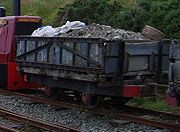
Modern Stock
The initial basis of freight stock has been supplemented in recent years by a series of flatbed runners (both four-wheelers and longer bogie stock), a large second hand four-wheeled brake van and a tipper wagon, the latter not being used in regular operation. As part of the Steam 125
Steam 125
Steam 125 was a series of events held in 1998 to mark the 125th anniversary of the Isle of Man Railway opening its first route from Douglas to Peel the railway ran a large number of special events. Most notable was the return to service of the original steam locomotive No...
railway celebrations that took place in 1998 the railway played host to its most unusual visitor, a hand made rail bike from Dr Karl Pischl in Austria. This unusual home-made vehicle was effectively a four-wheeled bicycle on flanged wheels.
See also
- Isle of Man Steam Railway Supporters' AssociationIsle of Man Steam Railway Supporters' AssociationThe Isle of Man Steam Railway Supporters' Association is a railway preservationist group dedicated to the continued operation of the Isle of Man Railway on the Isle of Man Since its inception in 1966 the group have provided volunteer workers and a watchdog role and commenced its own project in the...
- Manx Electric Railway stationsManx Electric Railway stationsThere are many local stopping places on the Manx Electric Railway and, as such, trams may stop wherever it is convenient to do so; listed to the right are all the acknowledged stopping places. The primary stopping places that have station areas built around them are as follows, and are those...
- British narrow gauge railwaysBritish narrow gauge railwaysThere were more than a thousand British narrow gauge railways ranging from large, historically significant common carriers to small, short-lived industrial railways...

